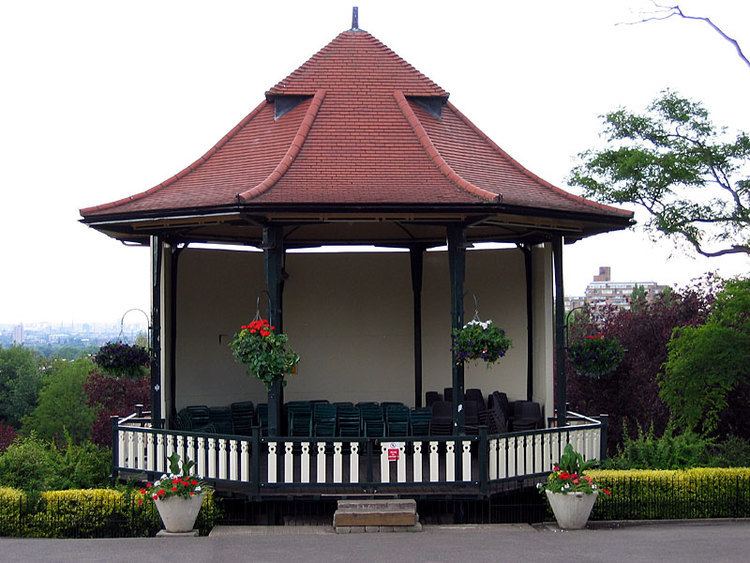 | ||
A bandstand is a circular or semicircular structure set in a park, garden, pier, or indoor space, designed to accommodate musical bands performing concerts. A simple construction, it both creates an ornamental focal point and also serves acoustic requirements while providing shelter for the changeable weather, if outdoors.
Contents
- Map of Bandstand Promenade Ranwar Bandra West Mumbai Maharashtra 400050
- Origins
- History in Britain
- England
- Scotland
- In arts entertainment and literature
- References
Map of Bandstand Promenade, Ranwar, Bandra West, Mumbai, Maharashtra 400050
Origins
Many bandstands in the United Kingdom originated in the Victorian era as the British brass band movement gained popularity. Smaller bandstands are often not much more than gazebos. Much larger bandstands such as that at the Hollywood Bowl may be called bandshells and usually take a shape similar to a quarter sphere. Though many bandstands fell into disuse and disrepair in the post-World War II period, the cultural project the Bandstand Marathon has seen bandstands across the U.K utilized for free live concerts since 2008.
History in Britain
The parks where most bandstands are found were created in response to the Industrial Revolution, when local authorities realized worsening conditions in urban areas meant there was an increasing need for green, open spaces where the general public could relax. The first bandstands in Britain were built in the Royal Horticultural Society Gardens, South Kensington in 1861. Bandstands quickly became hugely popular and were considered a necessity in parks by the end of the 19th century.
To assist the war effort during World War II, iron fittings were removed from many bandstands to be melted down and transformed into weapons and artillery. Many bandstands fell into disrepair and were boarded up in the late 1940s and 1950s. Other attractions – such as the cinema and television – were becoming increasing popular and traditional recreational parks lost much of their appeal.
Between 1979 and 2001, more than half of the 438 bandstands in historic parks across the country were demolished, vandalized or in a chronic state of disuse. In the late 1990s the National Lottery and Heritage Lottery Fund invested a substantial sum in the restoration and rebuilding of bandstands across the country. As a result of this funding, over eighty bandstands were either fully restored or replaced. Between 1996 and 2010 there was over £500 million worth of investments in parks - a significant chunk of this money was spent on the restoration and building of bandstands.
England
In 1993 the Deal Memorial Bandstand was opened as memorial to the eleven bandsmen killed by 1989 Deal barracks bombing. The bandstand was erected by public subscription and is maintained by volunteers.
A good example of a semi-circular bandstand is the Eastbourne Bandstand, built in 1935 to replace a circular bandstand that stood on cast iron stilts. Herne Bay, Kent contains a totally enclosed bandstand with a stage and cafe area, topped with copper-clad domes.
There is a very old bandstand at Horsham's Carfax, built in 1892 by Walter Macfarlane & C at the Saracen Foundry in Glasgow, and another one in its adjacent park. It was moved slightly from its original location, to better accommodate pedestrians and then refurbished in 1978 with funds raised by the Horsham Society and with council funding. In 1992, the original design was rediscovered in museum archives and it was then restored to its original colour scheme.
Scotland
Scotland's many ironwork foundries and manufacturers built bandstands that were subsequently erected at locations throughout the United Kingdom.
Some of the most notable bandstands in Scotland are located at:
In arts, entertainment, and literature
The function of the bandstand inspired the names of:
